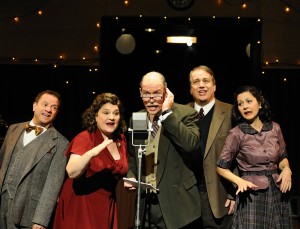It’s A Wonderful Life: A Live Radio Play by Joe Landry, Trinity Repertory Theatre, 12/3/10-1/2/11.
http://www.trinityrep.com/on_stage/current_season/MTM.php
Reviewed by Becca Kidwell

Resident acting company members Stephen Berenson, Anne Scurria, Timothy Crowe, Fred Sullivan Jr. and Angela Brazil in It’s a Wonderful Life: A Live Radio Play adapted by Joe Landry, co-directed by Curt Columbus and Tyler Dobrowsky. Set designs by Michael McGarty, lighting by John Ambrosone, costumes by Alison Walker Carrier. (photo: Mark Turek)
Trinity Rep brings a warm new tradition to its stage. The endearing story of George Bailey receives new life in this stage adaptation by Joe Landry. The production does not offer perfection, but it does offer a fun family night out. Set in a 1940’s radio station, the talented five person cast portrays all of the main characters from the story.
The cast consists of the following acting company members: Stephen Berenson, Angela Brazil, Timothy Crowe, Anne Scurria, and Fred Sullivan, Jr. who have proven themselves time and again in dozens of Trinity shows. The play creates a challenge for the actors since the characters are linked with iconic performances such as: Jimmy Stewart, Donna Reed, Lionel Barrymore, Thomas Mitchell, and Henry Travers; however, the cast manages to uphold audience expectations while making the roles their own. The only characterization that falls short is Fred Sullivan, Jr’s depiction of George Bailey. Mr. Sullivan’s performance turns George Bailey into a Zen master. George Bailey no longer has any urgency or reason to get upset; he remains calm in all situations. When he does yell, it seems out of place and forced. While this is an admirable quality for any person, it removes the sense of urgency, the anxiety, the anger, and even slight bitterness that causes George to feel trapped in Bedford Falls; the lack of passion also makes the thought of a suicide attempt seem absurd for someone that calm who could take a few moments and reason it out.
The radio show set up is enjoyable and is true to its intent. The Foley Artist adds to the feeling of being at a live radio broadcast. Despite the appropriate staging, Curt Columbus and Tyler Dobrowsky lose sight of the radio show format halfway through. It is understandable to be cautious about having actors perform with minimal action for eighty-five minutes and hope that a modern audience will pay attention and not get bored. With the main portion of the play as a radio show and the other part as a regular theatrical performance, the audience gets jarred and does not completely know what is going on, though. The Foley Artist disappears and canned sound effects are used. The microphones are taken away. So, we’re not at a radio play anymore? By the time this happens, the audience has bought in to the radio performance and expects it to continue this way. Some of the dramatic effect that is intended loses its impact while the audience readjusts to the new format. The tension and suspense could have been expressed through the lighting and limited movement without changing the structure of the play.
Overall, even with these missteps, the play is a delight and warms the heart. For a holiday “warm-fuzzy”, It’s A Wonderful Life: A Live Radio Play reminds us of the honesty and decency of man that we often seek and rarely find. Furthermore, it provides a new spin on an old tradition and gives the audience a new way to experience a classic story. TNETG. 12/11/10.
